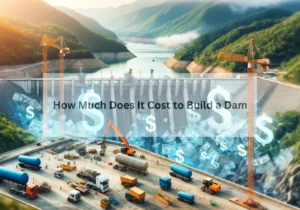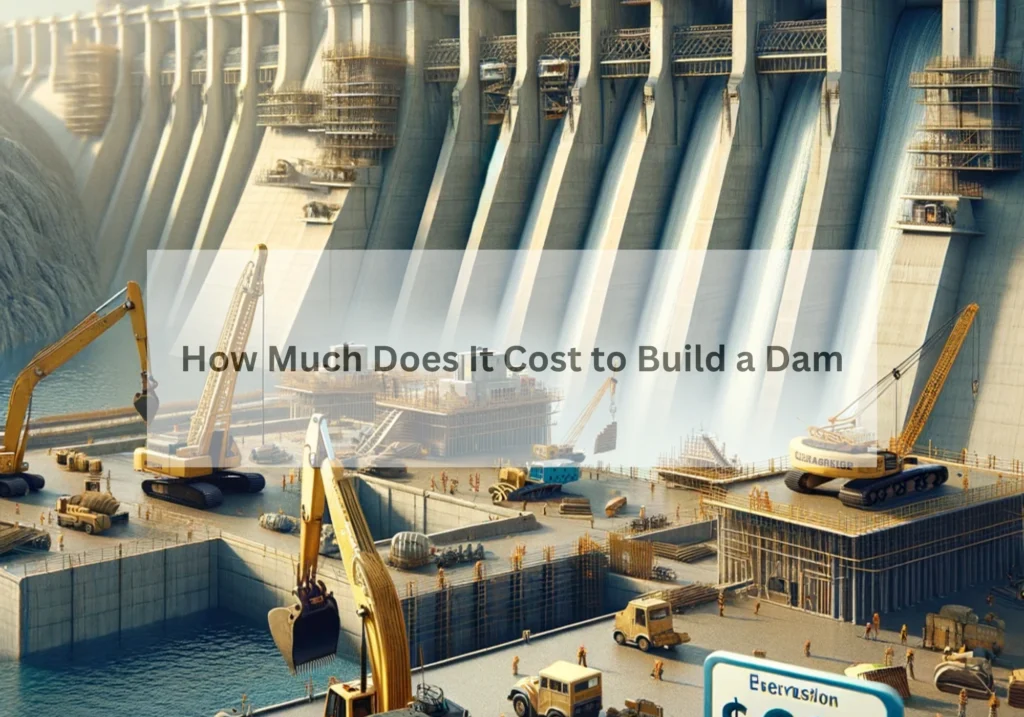Dams are a type of barrier that plays an effective role in retaining water and also maintaining water levels. It is made for various reasons: laying water in certain areas, generating hydroelectric power, and even storing water in rivers.Dam construction is an expensive as well as time-consuming task. Through this article, we will try to give you other possible answers, including the actual cost of building the dam as well as a hydro project.
What is a dam?

A dam is a kind of wall or a barrier structure across a river, stream, or waterway to stop the flow of water. Dams are also constructed to supply water for human use, irrigation of desert and semiarid terrain, and industrial activities. Hydroelectric power is often employed in combination with dams when it comes to generating energy. A large number of dams are constructed for more than one function. Multipurpose dams are a form of water-control structure that is often used for a variety of purposes.
How Much Does It Cost to Build a Dam?

The average cost to construct a dam might vary as it relies on how large it is, as well as what it is used for. A standard dam with such a water storage capacity of around 2.5mgl will expense around $20,000, dependent on on-site constraints. Mid-size 5mgl liters water capacity dam will cost around $50,000. A big dam project with 10mgl/20mgl liters water capacity will cost from $80000 to $120,000. Source
How much does it cost to build a hydroelectric dam?

Hydroelectric dams differ from ordinary dams in terms of construction and performance. Moreover, its construction cost varies. The construction cost of a hydroelectric dam depends on which hydropower technology you are going to use. According to Navigant Study, a Hydroelectric dam will cost around $1,000- $ 6,000 per kW to build. When it comes to cost per MW, it should be between $1.00 million to $6.00 million for the building of the full project, including ancillary infrastructure. Source
Different Types of Dams
There are different types of dams depending on the construction technique or structure, the purpose of the use or the construction material. Below is a discussion of some of the common types of dams:
1. Arch dam
The arch dam has a curved shape in design with its convex inflow. The dam’s arch action resists a variety of external stresses. Masonry or concrete may be used to build it, although it takes less material than a gravity dam. These abutments of the dam take on the weight of the loads that are brought to them by the dam.
2. Embankment dams
The embankment dams are massive man-made structures. It is usually made by placing and compacting a complicated semi-plastic mound of diverse soil or rock compositions. It features a solid, impenetrable core and a moderately waterproof natural coating for its surface. The Earth-filled dam that is built of compact earth, as well as the rock-filled dam, are the two kinds of embankment dams.
3. Buttress Dam
A buttress dam has a face, a buttress, as well as a foundation. The upstream edge has a face slab with an incline, which is maintained by a set of buttresses. The foundation slab supports the full dam, which is supported by buttresses as well as a face slab. Buttress dams may be linear or curved.
4. Barrage Dams
The barrage dams are a kind of barrier that is made up of a series of big gates that can be opened and closed to regulate the quantity of water that passes through it. The gates are positioned between two flanking piers that sustain the water weight. Irrigation dams are also used to manage and stabilize the flow of water.
5. Gravity Dam
The gravity dams are gigantic concrete dams that is able to contain vast amounts of water. The dam is able to withstand the horizontal push of the water due to the hefty concrete utilized, and gravity effectively binds it to the ground. These dams are used to obstruct rivers in large valleys.
6. Fixed-crest dams
These kinds of dams are river crossing barriers made of concrete. These dams are built to keep the river enough deep for navigation. They are difficult to notice from the water and produce induced currents that really are challenging to escape.
7. Hydroelectric Dam
One of the most essential aspects of a hydroelectric power plant is the hydroelectric or hydropower dams. This dam is a massive man-made structure designed to keep a body of water contained. Dams are built for a variety of reasons, including hydropower generation and also the control of flow and floods.
8. Steel dams
Steel dams are used for temporary purposes, such as wood dams, to hold back floodwaters. When building a steel dam, steel plates, as well as inclined struts, are employed as structural elements. Dams of this sort are appropriate for use up to a height of 15 meters to 18 meters.
9. Timber dams
Traditionally, timber dams are used for temporary reasons, such as diverting water during the building of a larger dam or controlling the flow of floodwater, among other things. Timber dams are appropriate for use up to a height of 9 meters.
10. Concrete Dam
Dams are most typically constructed using concrete, the most common material utilized. Concrete is used in the construction of the majority of the world’s major dams. Concrete may be used to build various dams, including gravity dams, arch dams, and buttress dams.
What is the Main Purpose of Dams?
In fact, a dam is built for many purposes. The main function of a dam can vary depending on the purpose for which you are going to build a dam. However, Flood control is a key reason for most of the dams, and it remains the primary purpose for several of the world’s largest dams now under construction. Dams are also built on rivers to generate hydroelectric power.
Dams are also an essential source of water for both home and industrial usage. Dams store water as well as provide it when there is a shortage. The other most important reason for building a dam is storing the water and utilizing it for agriculture. Dams offer irrigation and enable inland transportation across the country’s heartland.
Are dams good or bad?
Dams are used to retain water, control water pressure, generate renewable energy, as well as prevent disastrous floods. Unfortunately, they also contribute to the worsening of the effects of climate change. They contribute to global warming by releasing greenhouse gases, depleting carbon sinks in wetlands and seas, depleting ecosystems of nutrients, destroying habitats, rising sea levels, polluting waterways, and displacing low-income populations.
Advantages and disadvantages of dams
Although the dam has many advantages as it is constructed for different purposes. However, there are some disadvantages of the dam; In particular, it has an adverse effect on the environment. In this section of the article, we will discuss the advantages and disadvantages of dams.
Several Advantage of Dams
There are a lot of economic benefits of dams, such as they support navigation, flood control, recreation, irrigation, as well as water supply. Here are some of the advantages of Dams are listed below:
· Help to retain water supply
The first and foremost advantage of the dams is they help to retain the water supply. In drought-prone areas, the river dries up at a certain time. At that time, farming in the area was disrupted, and there was a shortage of drinking water. In such a situation, dams are constructed at certain places of the river to retain water in the river, which can be used while needed.
· Source of energy
One of the advantages of the dam is that it serves as a source of renewable energy. Many of you may be familiar with the concept of hydropower, and the only way to generate hydropower is to build a dam on the river. In this case, electricity is possible without burning any window or without any chemical reaction.
· Help to control flood
Dams can avoid property damage and save lives during yearly flooding occurrences. With these buildings, we can regulate the floods and store them for later use. It is possible to channel extra rainwater to communities for drinking water, increase irrigation options, and satisfy other energy demands. So, how do dams prevent flooding?
Dams prevent floods by collecting and storing water whenever it reaches a specific level. A dam collects water and discharges it into the riverbank at a regulated rate. A flow-through dam often referred to as a perforated dam, is indeed an example of this. Flow-through dams are solely developed for flood prevention and are intended to protect lower regions from flooding.
· Firm Navigation
River dams may be used to provide a reliable inland water transportation infrastructure. This technology may be used to provide a secure space for people to convey goods and other necessities.
· Provides a stable system of water transport
River dams stabilize inland water transport. Using this technology to install locks gives a secure area to transfer products and many other advantages. Dams may sometimes improve the protection of the environment. This method may help retain hazardous chemicals or reduce sedimentation in waterways.
Disadvantage of Dams

There are also some disadvantages of having so many advantages. Below are some of the disadvantages of the dam:
· Environmental impact of dams
Because of the engulfment of vegetation throughout the water, such plants ultimately die, releasing methane into the atmosphere. There is an increase in global warming and climate change since methane is 20 times more powerful as a reflection than carbon dioxide.
· Disrupts local ecosystems
As a means of forming a reservoir, dams cause flooding behind the building. This not only causes disruption to human operations but also damages existing animal habitats. This problem has the potential to destabilize whole ecosystems. It might have a negative impact on a whole geographical biome.
· Effects on various aquatic animals
The construction of dams on rivers can have adverse effects on various aquatic animals. The construction of dams on the river results in a change in the course of the river, which can cause damage to aquatic life. Their biological systems are tailored to the natural river environment as well as flow regimes.
· Maintenance Issue
Due to several issues such as evaporation, maintaining the reservoirs behind these dams is difficult in times of drought, making it difficult to meet the requirement for drinking and irrigation, resulting in an increase in environmental concerns.
How can we reduce the environmental impact of dams?

Dams, the conventional method of extracting the energy of flowing water, are not quite as environmentally friendly as you may imagine. It’s wreaking havoc on river ecosystems, diminishing biodiversity, as well as tampering with water quality. So, how can we reduce the environmental impact of dams?
Restoring fish passage is one of the major focuses. Numerous large dams lack fish ladders and hence impede fish movement. As temperatures rise, migratory species, including salmon as well as steelhead, require access to cold-water breeding habitats above dams.
It may easily outweigh the initial construction cost of certain major dams. Trap-and-haul operations, which gather fish and transfer them by tanker truck outside dams, and different motorized lifts are among compromise solutions. The most unique is a DOE-funded “salmon cannon” that can discharge adult salmon more than a dam via a tube.
Reforming the water release schedule and intensity is another need. Natural systems developed with storm-driven river flows, not the steady, low-intensity discharges of hydropower. For example, the Colorado River’s Glen Canyon Dam has used brief bursts of high-velocity water to help restore riparian habitat. These fluctuating flows also satisfy river enthusiasts like rafts and kayakers.
Reservoirs are also being studied for their greenhouse gas emissions. When plants and algae decompose, reservoirs generate large volumes of methane, a potent greenhouse gas. Managing erosion from the upstream watershed as well as regulating water levels more carefully may be solutions.
Wrap up
Although the dam is costly to build, it is still important to install it to place it where it is needed. A dam provides us with facilities ranging from hydropower generation to flood control, and water storage. The dam has numerous advantages as well as some disadvantages. However, proper prior planning is able to effectively reduce the limit of these disadvantages to ensure Environmental Protection. Learn more: about how much does it cost-related blog articles.

Cycling training tips and camps with Joel Chavez, Pan-American Gold Medalist has been writing about savings and finance since 2016 and analyzes thousands of products to find you the best deal. He will help you save money while you shop. They cover huge products including home, garden, car, business, tech, and many more for making the best financial decision.






1 thought on “How Much Does It Cost to Build a Dam?”